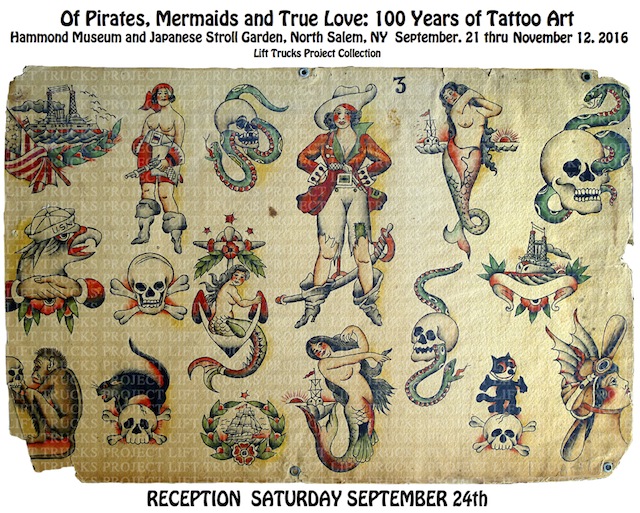
The guy's name is Harry Lawson, right?

Recently looked at a sheet that was unidentified. It's early and nicely drawn. We wanted to try and identify the author, if possible.
There's a date; May 20th 1930 written in pencil and erased under the eagle wings of the crossed equator design. Which caused us to look further. Scotty in the Lift Trucks Lab found another erased set of letters at the bottom of the sheet. Looked like "...rry V Law...n. He then looked at it a different way by flipping colors on the computer to a negative. Almost like a blueprint. You can see it clearly in person, not so much in the photo (apologies.) But you get the idea. All falls into place and says in all caps; HARRY V LAWSON.
Not a bad way to check for signatures on a sheet. Flipping some colors will work better than others. Old computers sometimes have a color matrix rotation system button. On newer models, try Photoshop or iPhoto and swap out one color for another.
One tell was the unique style of feathered shadows under the feet of the women. A black line with fade cast. This is on other Lawson's in a book. Shows up here on the ukulele girl and pirate lass giving stylistic evidence, along with the block letter signature, that sheet is most likely by Harry V. Lawson.
Maybe another reason to dig back into into the slag heap of unidentified tattoo flash sheets.

Click image to see enlarged. block letters: HARRY V LAWSON
Ed's Tatoo Parlour
Tattooist: How about a butterfly on your hip?
Teenage Girl: Its like you read my mind!
Will be stopping by Ed's. Location rocks, stumble on over with me, matey. Must be lovely, rear of Finn's bar. Although not a confidence builder having the word "tatoo" misspelled on his shingle. All doubts were quickly dispensed seeing the classy English spelling of the word Parlour. Wonder what city this was in? Must have been back east somewhere. I don't exactly remember. Heh, heh. You going to finish that Rob Roy?

Aloha, Baby

Here's a sheet of tattoo flash that surfaced at an obscure auction. Story was that it originally came through a swap meet in Northern California, not sure what one but maybe the now defunct Marin City. Which was a very cool place where lots of hippies would set up selling stuff from wealthy guys like the Jefferson Airplane musicians. Phil Ochs widow was there a lot. Kind of sad actually but she had nice things for sale and was a nice person. A well heeled town with good items not just sand candles and yarn dream catchers but expensive bikes, early electronic gear and mint Bill Graham Fillmore posters.
Anyway the auctioneer said the guy who owned the sheet of flash remembered that he got it from Albert Morse. Mr. Morse was a famous comic book artists' lawyer (don't mention his name to comic book guys, as they will spit and fume.) Unhappy dealings! They cry.
Albert Morse traveled the country and documented many tattooists. A hero in this world as he preserved history, wrote The Tattooists and had a great tattoo art show at the Oakland Museum of Art 25 years ago. Brought tattoo panels out of back rooms onto museum walls and the public eye.
We originally thought this piece might be Owen Jensen's as the girl and peacock is something he drew occasionally. But the fine line drawing just isn't his. It kind of looks Californian even though it says Aloha Hawaii. Beautifully done, it and now positively identified as an Earl Brown sheet.
Eagles, Two Maidens and a Tiger
This article is by Chuck Eldridge at the Tattoo Archives in Winston-Salem, North Carolina. Reprinted here by his kind permission. Mr. Eldridge is a tattooist, and an acknowledged historian on the subject of tattoo history. If there is anything you want to know about the Tattoo World, Mr. Eldridge is your man.
http://www.tattooarchive.com/
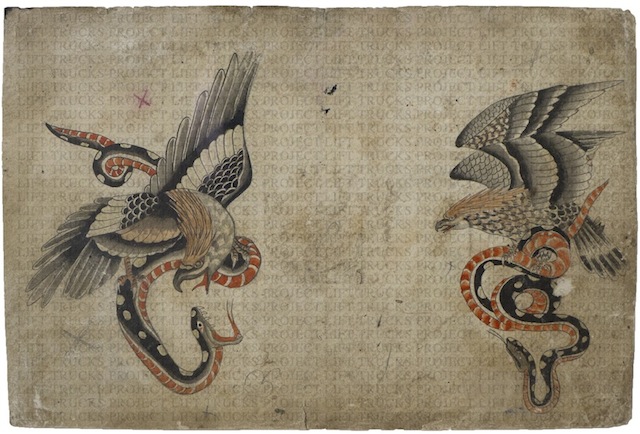 George Burchett George Burchett was probably the most famous tattooist of his era, which spanned from 1890 through 1953. Tattooing in London through two World Wars, Burchett catered to both the rich London society and the poor alike.
George Burchett George Burchett was probably the most famous tattooist of his era, which spanned from 1890 through 1953. Tattooing in London through two World Wars, Burchett catered to both the rich London society and the poor alike.
Born George Burchett Davis in 1872 in Brighton England, George did his first “scratching” (as he described it) on his schoolmates. One of his first customers was his younger brother Charles, who at the age of four or five was wiling to pay the large fee of a stick of liquorices for the pleasure of being scratched by George.
George Burchett joined the Royal Navy at the age of thirteen and found that his ability to “scratch” was welcome. Navy discipline proved too much for the young George, so he jumped ship in Tel Aviv and did not return to Great Britain for twelve years. In order to avoid the authorities George Burchett Davis dropped his last name and became George Burchett. During this part of his life, he worked as a tram conductor and a cobbler, but continued tattooing part time. In 1900 he became a full time tattooist. During the next half century and until his death in 1953, George Burchett created one of the largest tattoo practices in the world.
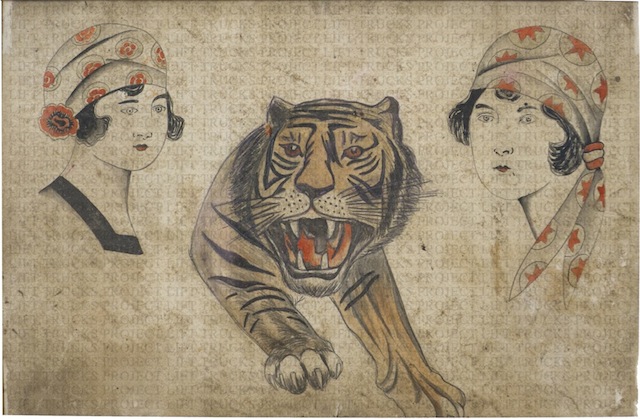 Charles Davis
Charles Davis
Charles Davis followed in his older brother's footsteps into the tattoo world, but never received the acclaim that George did. The brothers worked together and operated shops separately for many years. George and Charles were just a few years apart in their ages. It's difficult to tell them apart in photographs today, with both of them dressed in white shirts, vests and ties, and sporting well-trimmed mustaches and matching shoes! They both even liked to work in white medical smocks. Their tattooing styles were so similar that it is difficult to tell their tattoo designs apart. In later years Charles stepped away from tattooing, and in the 1950s George wrote that Charles was active in the insurance business.
Restoring Tattoo Drawing
How to clean up a century old piece. Removing later additions and bring back to original.
Picasso vs Sailor Jerry
We have been through the Picasso sculpture show at MoMA twice. It did not get better. Seemed careless and sloppy in both thought and in execution. He did not stick a baby cake server on a pile of Playdough once, but 30 times over. Our artist friends enjoyed the "playfulness" or some such rot. They said he explored the exploding of imagery. We say 3d telephone doodles.
Let's compare: Who had a tougher audience?
Picasso had to amuse laudenum addled bohemians lounging around Montmarte cafes as Nazi's paraded down the Champs Elysees.

Pablo Picasso

Picasso sculpture from MoMA.
Sailor Jerry created art for tough guys on shore leave, repairing from Pacific Rim battles with the Japanese.


 Sailor Jerry.
Sailor Jerry.
We know whose art we have on our walls ,Matey!
Charle "of Malta" Parnis

Compare these three head shots:
1. From Lift Trucks contributor.
2. Long sheet found in Dusty Rhodes’ studio.
3. Charlie “of Malta” Parnis, early 1900s. Collection of Hanky Panky, Amsterdam Tattoo Museum. From Pierced Hearts and True Love: A Century of Drawings for Tattoos, The Drawing Center.
Lab staff sent packing along with our scientific laboratory of expensive machinery. We now trust in knowledge the passed down through generations, the good eyes and common sense of our friends in the tattoo world. Great analysis that has shed light on a previously unexplored subject regarding tattoo flash painted over 100 years ago. Difficult task indeed.
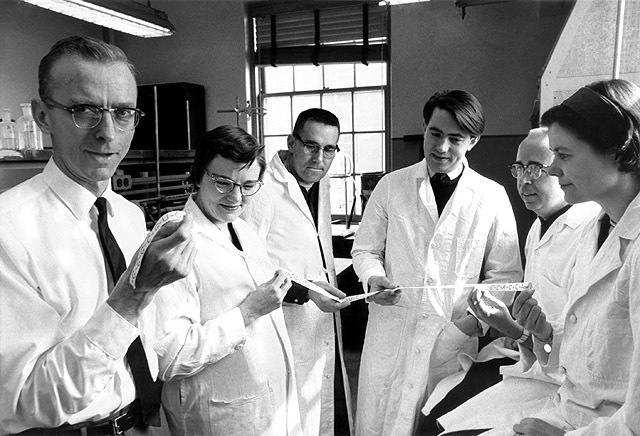 Clear out your desks.
Clear out your desks.
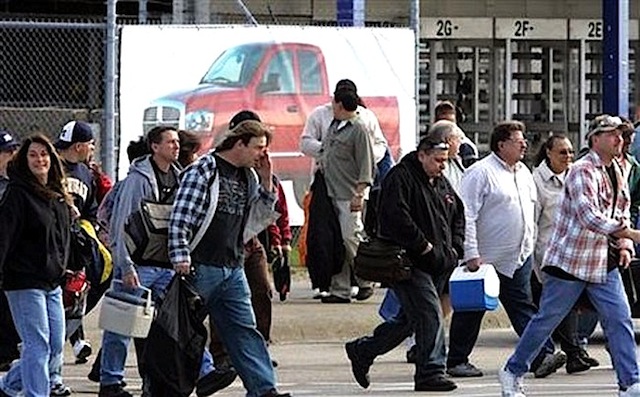 Schools out forever for these Lift Trucks employees and their shoddy research.
Schools out forever for these Lift Trucks employees and their shoddy research.

Fill high the dumpster!
We now trust the eyes of our friends. Many thanks again to Messrs. Skuse & Shudehill.
We now must have any help with information regarding the mystery of Charlie,of Malta,Parnis.
First question: Did he live ever in Malta, or was he an Englishman with Malta as his calling card, much like "Brooklyn" Joe Leiber? A man who reportedly never set shoe leather down once in the good borough.
Of Dragons, a Cat, and a Woman in a Heart
Mr.Thomas Berg was an English tattooist who came to the United States at the turn of the century. He is known to have tattooed in San Francisco where he worked doing hand and electric tattooing. As with many tattooists of that era, Berg offered designs, stencils and color for sale.
His shop along with Capt. Jack Howard was in one of the roughest and toughest sections of old San Francisco – the so-called Barbary Coast area was lined with whorehouses, opium dens, shanghai bars, flop houses as well as the more up-scale "parlor houses." His flash designs were quite detailed for that era and he probably worked with a single needle set-up, which was not unusual in England at the turn of the century.
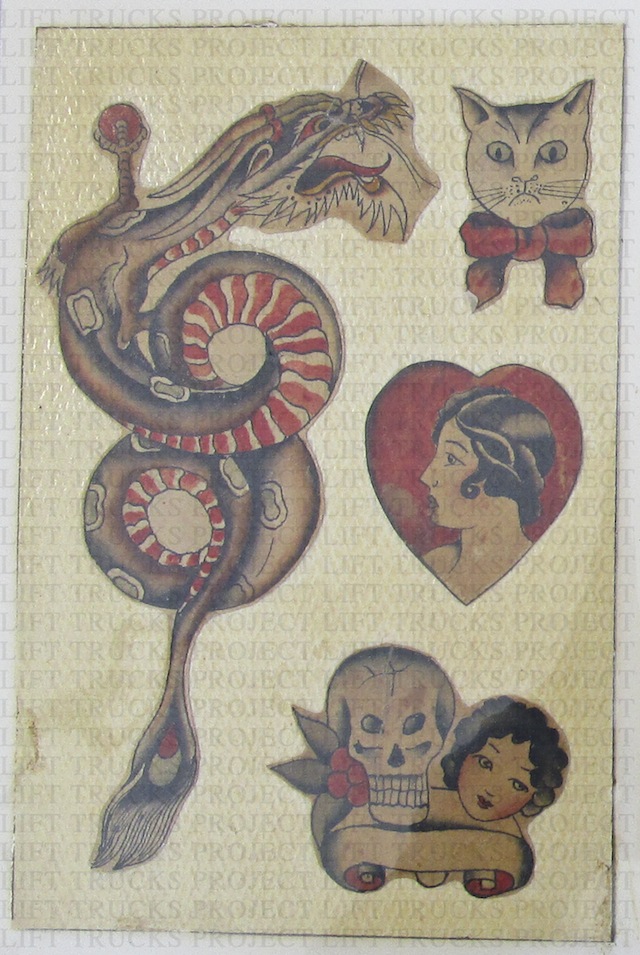
The fantasy drawing of a dragon is particularly compelling. A Japanese influence fish tail imparts the look of an angry eye. Even more peculiar is ol’ sour puss in the corner, all too reminiscent of the internet-famous Grumpy Cat (8.6 million fans on Facebook.) Even the scroll under the skull and girl looks like the back bumper of a 1960s land-yacht. Thomas Berg, we hardly knew you, but your timeless artwork aged beautifully.
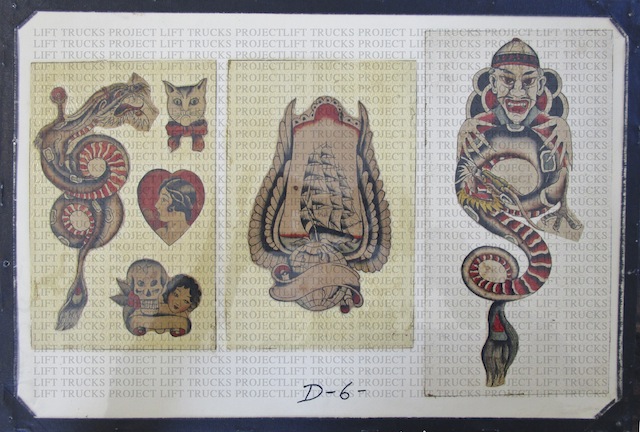
Yes Yes, And Furthermore...
Here's something we know. This sheet was done by Dusty Rhodes aka Professor Manley.
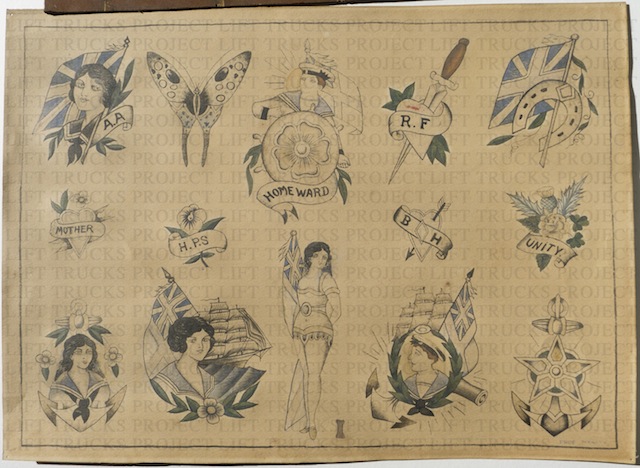
It's signed.

The dude's full name was Manley Raymond "Dusty" Rhodes (1890-1962.) Our professional research team at LTP confirms: The hand that wrought this had nothing at all to do with the big framed panel that hung in his studio.
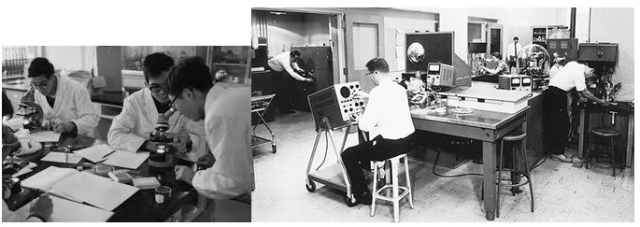
Compare the knives and faces.

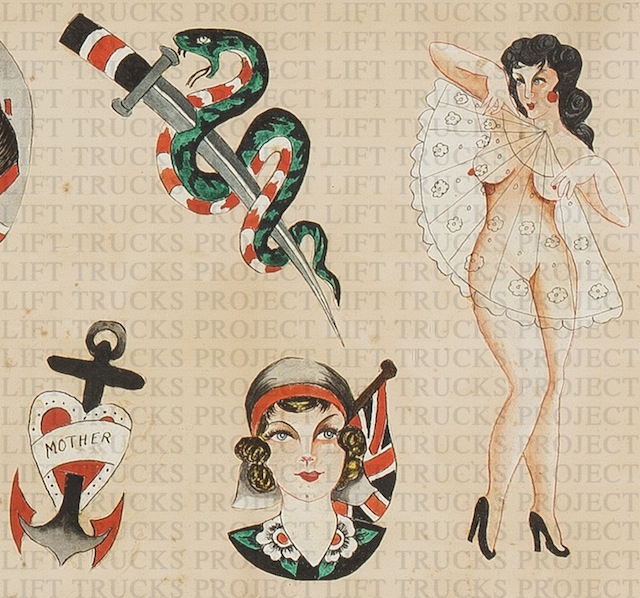
But as a wise collector once said: Let's just sit back and dig these tattoo masters. They are the true and real artists of the last Century.
Snakes and High Heels
From exhaustive electroscopic comparison analysis at our very own International Institute for Tattoo Art Research, a division of Lift Trucks Project, our studies have led us to the following determination. The large tattoo flash board from Dusty Rhodes studio is most certainly the handwork of Joseph Hartley.

One element of our research over the course of a couple of hours and in between other stuff, was to focus upon the written words. Lettering is, in itself, as telling and unique as a signature. No two people will pen a letter exactly the same way.

Selection from a book documenting Joseph Hartley work, by the esteemed expert, Mr. Hanky Panky.

A close up of the sheet found in Dusty Rhodes shop.
As we compare the individual letters in the word "NAME", note the outward curve on the right stroke of the “A" and the distinctive convex and concave lines on the "N". The way the center angle of the "M” does not descend as far as the other parts of the letter. Our research shows that in Hartley’s lettering most of the forms have the tops dramatically curving as if they’re leaning back and windswept.

Hanky Panky's book (Left) Dusty's sheet (Right)

Joseph Hartley sheet kindly sent by a Lift Trucks contributor. (Above.)

Board from Dusty's studio
We encourage our readers to look for these points of similarity. Snakes with distinct red/white underbelly's and black and green backs. Unique little dots around hearts. The women have stylized bright eyes, arched eyebrows, rosebud lips and heavy jaw lines... The final tells being the ladies tiny size 2 shoes and the fact that Hartely was well known to have supplied the Rhodes brothers in the 1930's with supplies from his Tattoo business in Bristol, England.
Just as sure as a clean fingerprint on a newly cracked safe, we believe this conclusively connects the art to the artist.
We also think this sheet is his ultimate masterpiece.
This of course, has nothing to do with the fact that we own the item.
Dusty Rhodes
The old tea china gently rattled as he walked down hand hewn wood stairs, fire cold dead now but for smoky remains. As he latched the door and walked the cobbled streets to work early morning sunlight streamed over mermaid shaped clouds. Shades of Dr. Jekyll and Mr. Hyde, Prof. Manley slowly became Dusty the Tattooist. Consumed with his near to waking dreams from the night before of Indian chiefs and red mesas, the most un-Brit women clad scantily whirling around with exotic snakes, fans and feathers, the ground littered with heads of evil marauders impaled with a Scotsman's Sgian Dubh knife. The fantasies ran another beautiful day in Grimsby, which, once fueled by fishing and maritime, was now headed into steep decline.
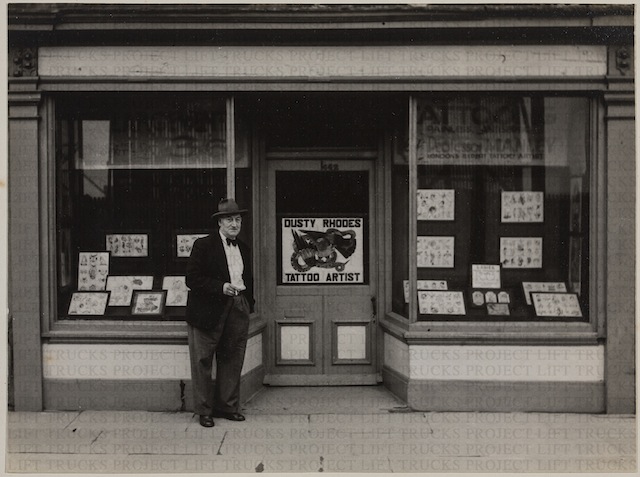
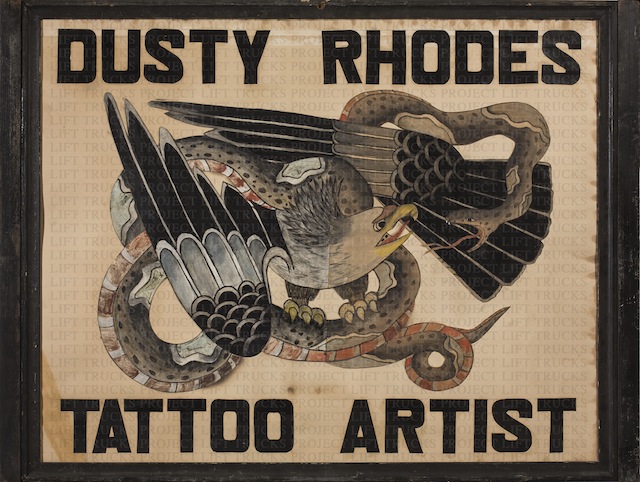
The town was not yet fully awake as Dusty lit his first cigarette outside the neat as a pin shop. A retired sea captain allowed a greeting as he stumped by. Neptune, God & Country and the Girl at port-side home were all a-waiting to be memorialized in tattoos. Children peering in the tattooists window were scooted down the road by overburdened mums.
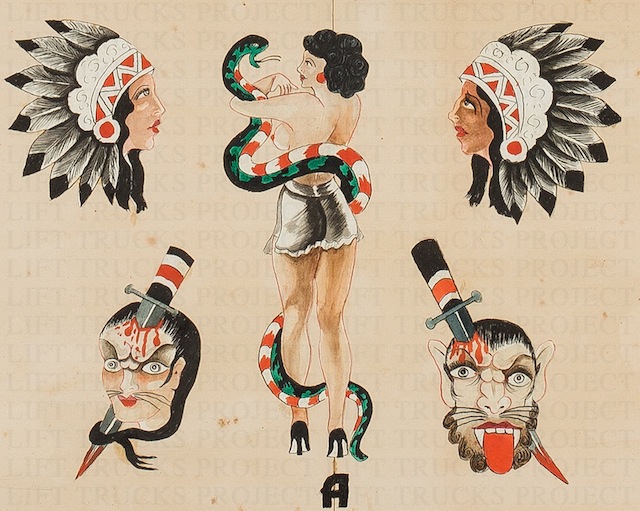
Manley "Dusty Rhodes" (1860-1962) was listed as a tattooist in Chatham, England 1911 although he spent most of his career in Grimsby. The designs above found in Dusty's shop, are most certainly by Joseph Hartley who sold flash samples and materials from his famous Bristol tattoo shop. This anonymous sheet below was found on the back of the Ladies Cheeks Tinted sign seen in window.
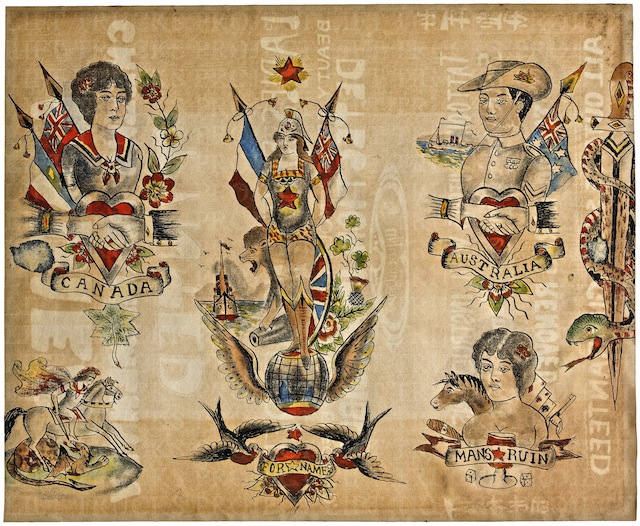
How lucky can one guy be?
What floats our boat about this flash sheet by the master tattooer, Earl Brown? Maybe it's about the good life. A girl in the bunny suit. Catch a wink and a nod from a lass in a pirate outfit. What's not to like? Five seductive pin ups all waiting to add their name with yours on a hearts or roses banner. The elongated "X" compositional symmetry is brilliant. Dead center, a demure raven-haired beauty in a black Wonderwoman bikini. She's bookended by two girls each sitting with a hand up. Look. They are waving. At ME! Are we biggie (Biggie Smalls) enough for the swinging brunette with hairstyle flowing down over one eye? Yes, we nod. Yes, we are.
As Dean Martin once sang: I got to get a tattoo at 12:30, don't want to be late. I hugged her and she hugged back. Like a sailor said quote "Ain't that a hole in a boat?"

Tattoo Auction
Many of our followers are diehard tattoo aficionados and collectors, and it’s easy to understand why. They know it’s rare to find the good tattoo stuff out in the wild, but we’ve got good news. We’ve gotten reports of an online tattoo auction to be held on the 13th & 14th - 1PM & 6PM each day, Eastern Time. It takes place at Guernsey’s in NYC’s Meat Packing District.

This collection was assembled by a Mr. Peter Mui, an actor, fashion designer, and musician. He traveled the globe collecting and learning about tattoo art, antiques and flash. His collection contains classic Japanese works such as Horiyoshi III to vintage tribal and biker tattoos, present day biomechanical creations and just about every other style you can imagine. Some of the items are a bit newer, for example there are plenty of comic book influenced designs, but diversifying the lot of over 1,000 items are things like a Victorian era English foot pedal operated tattoo machine.
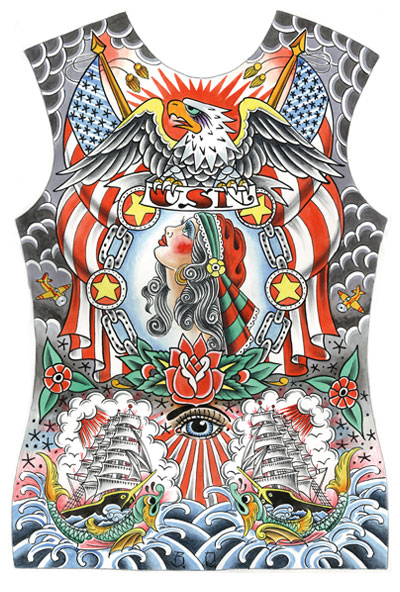
Lucky for Mui’s family, he left them an incredible and massive archive of tattoo art, which they’re selling it at one of Mui’s favorite auctions. A lot of the works in this collection are incredibly unique; from depictions of psychedelic Himalayan gods to 200+ year old Burmese tattoo books. I especially like the Himalayan stuff, reminds us of why we like Rosie Camenga, he was cool and weird.

Even if you’re not buying, you should keep an eye on the auction. For collectors, you wouldn’t want to miss this for the world.
You can learn more and register bid on the Guernsey’s website.
http://www.guernseys.com/v2/tattoo_art.html
Check out the collection.
Day 1: https://www.liveauctioneers.com/catalog/79955_tattoo-art-collection-day1-nov13/
Day 2: https://www.liveauctioneers.com/catalog/79957_tattoo-art-collection-day2-nov14/
Written by Scott Everett, student and project manager at Lift Trucks.

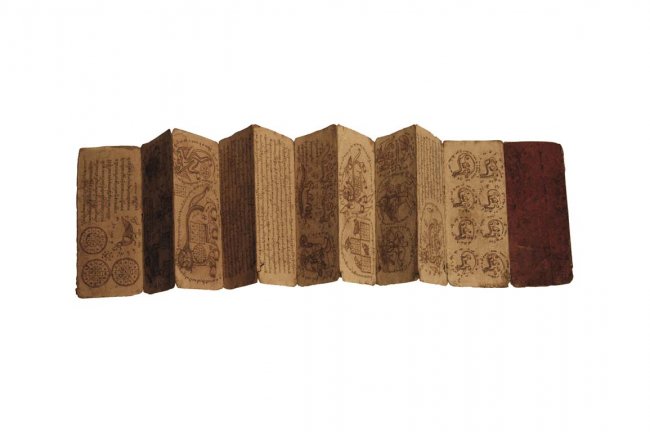
Sailor Jerry Master Draughtsman
These old tattoo guys were good. Try this at home. Copy freehand (no cheating by tracing) a Sailor Jerry dragon. Or anything else by one of the great masters like him. Not so easy.
Now, try to get it down on somebody's back at midnight in tight quarters with a large group of servicemen watching on a Saturday night in Honolulu's Chinatown. Rubber gloves on, buzzing tattoo machine, trying to get the right ink balance, light touch but the right touch. Ouch, the victim sez.
Just trying to copy the original drawing's enough for me. And doing a mediocre job at that, thank you very much. Really doesn't look that bad. That is, until you look at the original.

 Sailor Jerry, soft pencil on tracing paper, 11 by 14 inches, date unknown. From the esteemed Sailor Jerry Swallow collection by way of Mike Malone from the original China Seas, Honolulu, Hawaii.
Sailor Jerry, soft pencil on tracing paper, 11 by 14 inches, date unknown. From the esteemed Sailor Jerry Swallow collection by way of Mike Malone from the original China Seas, Honolulu, Hawaii.
Here There Be Dragons.
Like an inscription written in the turbulent sea-ed corner of an antique map of the old world these dragons speak of horrors in unchartered seas. Rolling in and out of waves. Think of these guys and you'll be sure to crush your collarbone body surfing the Wedge in Newport. Not to be trifled with matey, watch for these two coming up through a swell.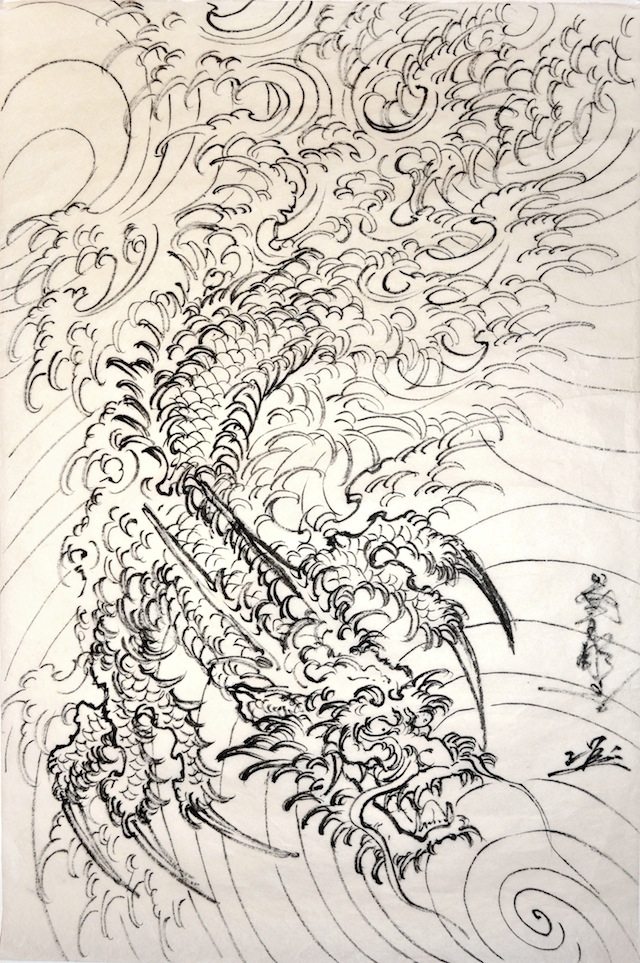
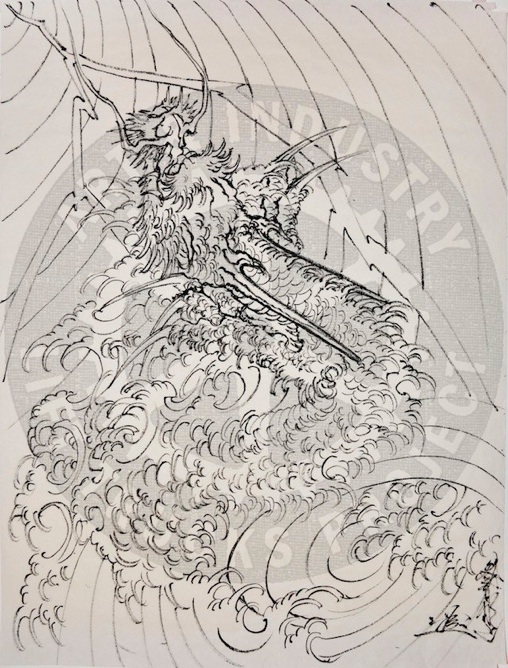
Born Yoshihito Nakano, Horiyoshi III (b. 1946) received his current title from the late tebori master Yoshitsugu Muramatsu, also known as Shodai Horiyoshi of Yokohama. Beginning at age sixteen, Horiyoshi III served as Shodai Horiyoshi’s apprentice for ten years. By age twenty-eight Horiyoshi III’s bodysuit was complete, hand-tattooed by Shodai Horiyoshi.
Though ukiyo-e officially ended in 1868, Horiyoshi III carries on the spirit of Edo’s “pictures of the floating world” in his work, all the while incorporating his own style and a contemporary perspective. This sensitivity to tradition extends beyond his tebori. In recent years, Horiyoshi has concentrated on traditional kakejiku (scroll paintings). Rendering Japanese folktales, calligraphy and religious subjects in sumi (black ink) and traditional mineral pigments, Horiyoshi III interweaves past, present and future.
In addition to painting and drawing, Horiyoshi III tattoos full time, publishes books of his drawings and is the founder of Japan’s only tattoo museum with his wife, Mayumi, in Yokohama. With over forty years of experience, Horiyoshi III is the foremost authority on traditional Japanese tattooing.
Luck of The Irish
Tattoo artists often employed popular characters for sample art boards hanging in their atelier. In this drawing by Thomas Berg, this pair from the comics are tossed in the mix with traditional sailors imagery of flags, dragons and, of course, mom.

Jiggs and Maggie
The humor centers on an immigrant Irishman named Jiggs, a former hod carrier who came into wealth in the United States by winning a million dollars in a sweepstakes. Now nouveau-riche, he still longs to revert to his former working class habits and lifestyle. His constant attempts to sneak out with his old gang of boisterous, rough-edged pals, eat corned beef and cabbage (known regionally as "Jiggs dinner") and hang out at the local tavern were often thwarted by his formidable, social-climbing (and rolling-pin wielding) harridan of a wife, Maggie, their lovely young daughter, Nora and infrequently their lazy son Ethelbert later known as just Sonny.
The strip deals with "lace-curtain Irish", with Maggie as the middle-class Irish American desiring assimilation into mainstream society in counterpoint to an older, more raffish "shanty Irish" sensibility represented by Jiggs. Her lofty goal—frustrated in nearly every strip—is to bring father (the lowbrow Jiggs) "up" to upper class standards, hence the title, Bringing Up Father. The occasional malapropisms and left-footed social blunders of these upward mobiles were gleefully lampooned in vaudeville, popular song, and formed the basis for Bringing Up Father. The strip presented multiple perceptions of Irish Catholic ethnics during the early 20th century. Through the character Jiggs, McManus gave voice to their anxieties and aspirations. Varied interpretations of McManus's work often highlight difficult issues of ethnicity and class, such as the conflicts over assimilation and social mobility that second- and third-generation immigrants confronted. McManus took a middle position, which aided ethnic readers in becoming accepted in American society without losing their identity. A cross-country tour that the characters took in September 1939 into 1940 gave the strip a big promotional boost and raised its profile in the cities they visited.
Courtesy Wikipedia.
Thomas Berg
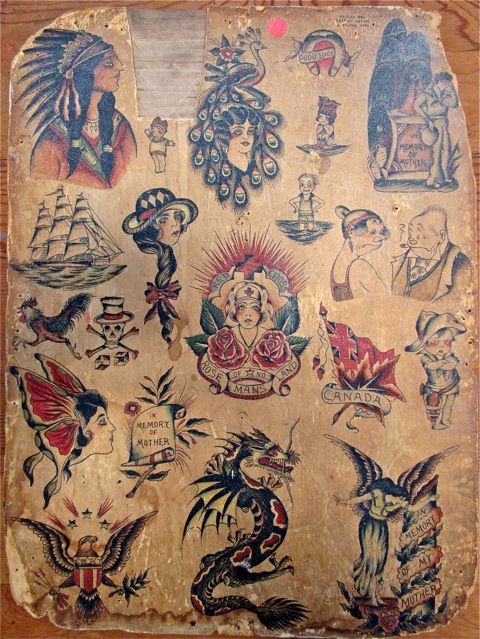
Attributed to Thomas Berg, c1920's, this piece has been through the ringer. Chopped out section poses an interesting story: Piece taken home by a famous person to test out, contained Japanese imagery unpopular in WWII , or perhaps a bully just wanted a chop?
We will never know but in the words of Jim Laporte famous tattooist from the NuPike:
"The piece, as it is, speaks to me of tiny, dark, hole in the wall shops.
Hidden in skid row areas where sailors come to seek that which is found in those places.
Cheap booze, female companionship for a fleeting moment and a lasting memento of that respite, a tattoo.
Always, your pal, Jim Laporte"
Swinging on a Star
Irene Woodward, born 1862, signed and incsribed "Age 20..." on this carte de viste. Probably for sale to adoring fans at the circus. That’s if we can believe she was 20 when she signed the the back of the card. My other job is working in a liquor store so I’ve gotten pretty good at guessing people’s ages. All women lie about their age, usually shaving off a few years but still, I would not card her. This young lady, as radiant as she is, probably is not under 21.
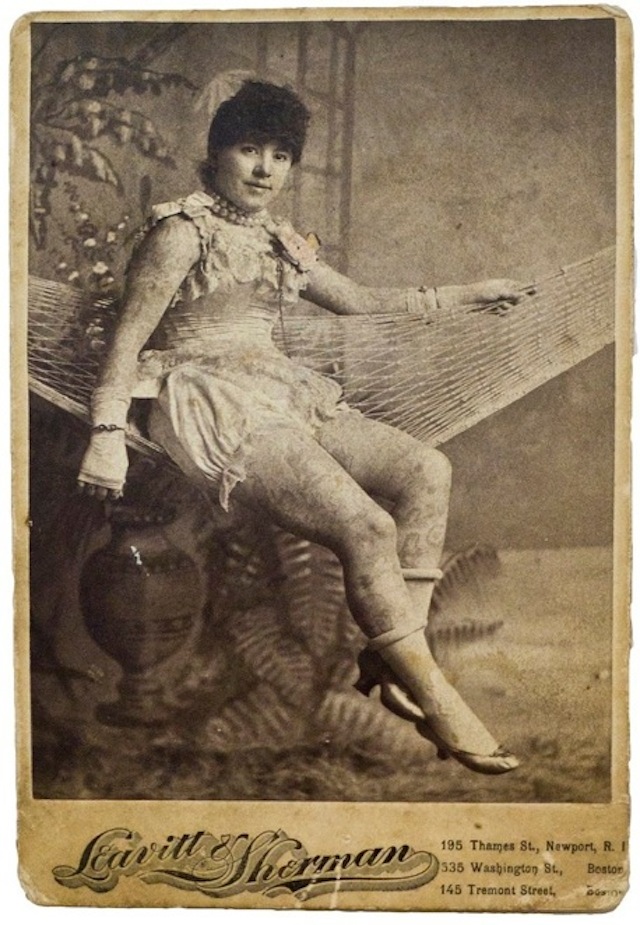
But she could have been tattooed around 1880, considering she was born in 1862. Eighteen might have been the legal age (if there was one) for this kind of enterprise.

She almost went down in history as the first tattooed lady in the circus game, short by only a few weeks.
The inking was most certainly done by Samuel F. O’Reilly. Although she claimed abduction by tribesmen in the South Seas, Mr. O'Reilly's signature swirls and embellishments can be seen adorning her legs. We love the hand tinted pink carnation on her shoulder. Nice touch Mr. 1880's Photographer guy!

Looks like somebody from " An Artist Formally Known as Prince" music video traveled back in time and got Shanghaied by a tattoo artist. Which just might have been the best thing that happened to Ms Woodward, because let’s be frank, the 1890’s must have been dreadful.
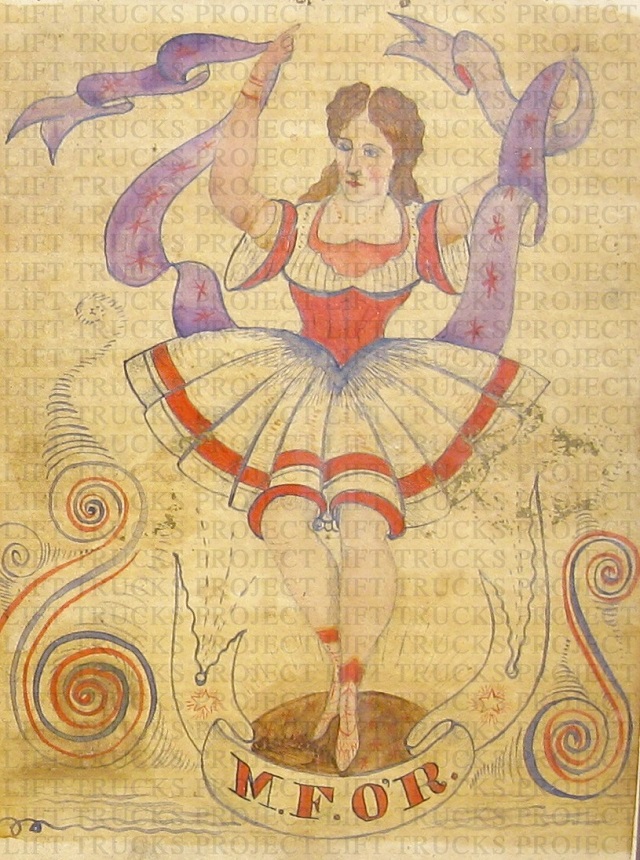
Cover page from an O'Reilly sketchbook. Note the swirls and action line dash's, all signatures of his splendid work.
We salute you, La Belle Irene!
And a tip of the cap to the master tattooist Samuel F. O'Reilly.
Thanks to http://wiki.bme.com/index.php?title=Irene_Woodward
"Irene Woodward, also known as La Belle Irene, was a tattooed lady who performed during the 1880s. She made her New York debut just weeks after Nora Hildebrandt to great fanfare, including a report in the New York Times. She worked at Bunnell's museum and successfully toured Europe. Onstage, she claimed to have been tattooed by her father, and, in a break from the usual tales of forcible tattooing, claimed she actually wanted the work done. Woodward was actually tattooed by Samuel O'Reilly and his then-apprentice Charles Wagner. At times, she claimed to have been inspired by having seen Constantine. In 1883, she married a showbiz man named George E Sterling with whom she had a son, also named George, and spent 15 years in the circus.
She died in December of 1915 at the age of 53 in Philadelphia, Pennsylvania."
http://wiki.bme.com/index.php?title=Irene_Woodward
http://ltproject.com/ltproject/Samuel_F._OReilly.html
The Greatful Crane
Cranes are common symbols and themes in the folklore of East Asia, including Japan. The Grateful Crane or the Crane Wife is a particularly well-known tale in Japan, see the resources below:
“The Grateful Crane” (Japanese fairy tale)
 Thomas Berg, circa 1910 (Detail)
Thomas Berg, circa 1910 (Detail)
Cranes are an important motif in Chinese mythology. There are various myths involving cranes, and in Chinese mythology cranes are generally symbolically connected with the idea of immortality (Eberhard, 1983: 75-76). Chinese mythology refers to those myths found in the historical geographic area of China. The geographic area of "China" is of course a concept which has evolved of changed through history. Cranes in Chinese mythology include myths in Chinese and other languages, as transmitted by Han Chinese as well as other ethnic groups (of which fifty-six are officially recognized by the current administration of China). (Yang 2005:4) The motifs of cranes may vary in a range from reference to real cranes (such as the Red-crowned Crane) to referring to transformed Taoist immortals (xian), who sometimes were said to have magical abilities to transform into cranes in order to fly on various journeys.

Samuel F. O'Reilly, circa 1880s (detail)


